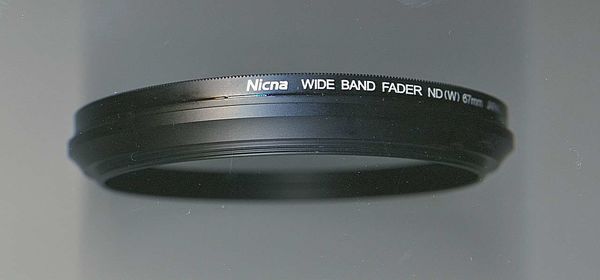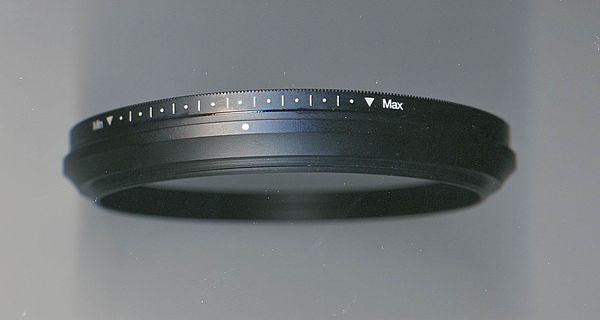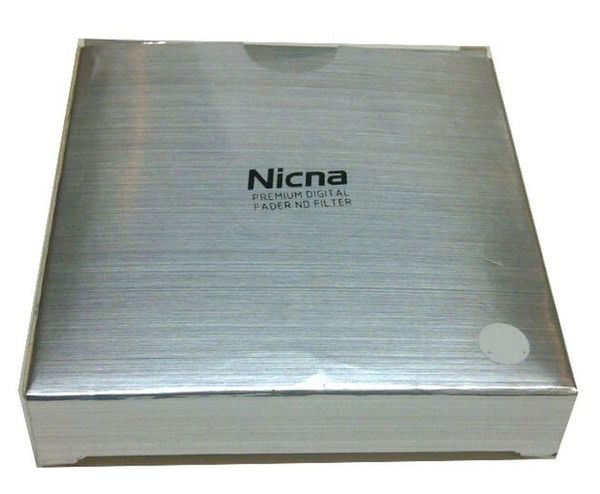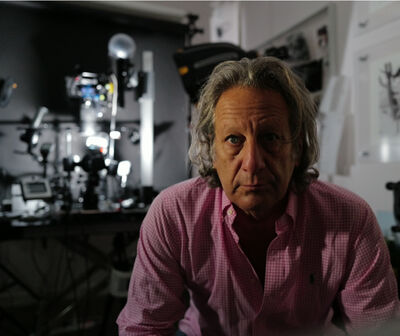ND Graduated Filter hits
May 13, 2021 16:25:01 #
Hello Hoggers. I am looking for advice on a ND Graduated Filter Kit for a Sigma 10-20mm and D7200. Any advice would be greatly appreciated. Thanks
May 13, 2021 17:15:46 #
Royce Moss wrote:
Hello Hoggers. I am looking for advice on a ND Graduated Filter Kit for a Sigma 10-20mm and D7200. Any advice would be greatly appreciated. Thanks
They are great fun, and I didn't buy expensive to start, Tiffen .05 Clear ND, and haven't found a reason to upgrade. I like to use it in the Golden hours at the wider end of a short zoom. You will need to try a variety of settings till you get the kinds of effects you are looking for. The only specific, important advice I can offer is to remember to adjust the Grad ND when you turn your camera from Landscape to Portrait. I will get shooting and forget- nearly impossible to fix after. You will have fun with it, but probably not use it a lot. A very good tool to have in the box.
May 13, 2021 18:00:38 #
Strodav
Loc: Houston, Tx
After quite a bit of research, I ended up with the Lee filter system. It has performed very well for me. The Lee filter holder holds a square glass filter that you can slide and rotate. You buy adapters for the filter holder to the filter sizes of the various lenses you want to use it with. I have an assortment of adapters, gradient filters and some uniform filters like the "Big Stopper" which is a 10 stop nd filter.
May 14, 2021 03:13:06 #
Hi Royce, I bought this one several years ago, it's variable and does the whole range from nearly clear to pretty much a complete black out. Cant remember what I paid but it wasn't expensive at all.
May 14, 2021 06:49:10 #
tcthome
Loc: NJ
With the replies from here, are you looking for adjustable or graduated? Try Breakthrough Filters for their kit if looking for graduated with the horizontal transition going through about center of the rectangular filter, Nisi, & Polar Pro are very good also.
https://theartofphotography.lpages.co/52-page-long-exposure-guide/
https://breakthrough.photography/
https://nisiopticsusa.com/shop/
https://www.amazon.com/PolarPro-PP-SMMT-ESSNTL-KIT-Summit-Landscape-Kit/dp/B0812CLLB3?crid=2HYKXQH8NK4UQ&dchild=1&keywords=polar+pro+summit+landscape+kit&qid=1615716565&sprefix=polar+pro+su,aps,244&sr=8-1&linkCode=sl1&tag=atti05-20&linkId=145b96e477edd62d7f20e220da41af14&language=en_US&ref_=as_li_ss_tl
https://theartofphotography.lpages.co/52-page-long-exposure-guide/
https://breakthrough.photography/
https://nisiopticsusa.com/shop/
https://www.amazon.com/PolarPro-PP-SMMT-ESSNTL-KIT-Summit-Landscape-Kit/dp/B0812CLLB3?crid=2HYKXQH8NK4UQ&dchild=1&keywords=polar+pro+summit+landscape+kit&qid=1615716565&sprefix=polar+pro+su,aps,244&sr=8-1&linkCode=sl1&tag=atti05-20&linkId=145b96e477edd62d7f20e220da41af14&language=en_US&ref_=as_li_ss_tl
May 14, 2021 06:58:42 #
Just by way of clarification, Royce, I presume you are referring to the kind of ND filter that changes density across its breadth. That is, one side of the filter might be clear while the other is greyed down to reduce light transmission by 2 or 4 or 10 stops. The Lee filter system mentioned by @Strodav includes this kind of graduated filter (they also have filters that are solid gray across the filter), and in generally well regarded. The filters themselves are generally square (4x4” as I recall) and you use a filter holder that is fitted to the front of the lens. THat holder rotates (so the gradation line can be horizontal or at some other angle) and allows you to move the square filter up and down (so the gradation does not have to be in the center of the image area)
Meanwhile, what @SX2002 has described is a so-called variable ND filter. This is basically comprised of two polarizing filters stacked together - as one is rotated agaist the other less and less light gets through. Different tool altogether. There can be issues with these kinds of filters when used with certain cameras (what’s called the “Maltese cross” can appear - it’s all about diffraction patterns and literally depends on the image sensor i a given camera - I know from personal experience they can be very convenient or simply useless). But if what you are seeking is the former type (usually used to darken a bright sky to bring it into closer illumination to the foreground) then you do not need a variable ND, you want a graduated ND like the Lee.
Hope that helps
Meanwhile, what @SX2002 has described is a so-called variable ND filter. This is basically comprised of two polarizing filters stacked together - as one is rotated agaist the other less and less light gets through. Different tool altogether. There can be issues with these kinds of filters when used with certain cameras (what’s called the “Maltese cross” can appear - it’s all about diffraction patterns and literally depends on the image sensor i a given camera - I know from personal experience they can be very convenient or simply useless). But if what you are seeking is the former type (usually used to darken a bright sky to bring it into closer illumination to the foreground) then you do not need a variable ND, you want a graduated ND like the Lee.
Hope that helps
May 14, 2021 07:41:36 #
Royce Moss wrote:
Hello Hoggers. I am looking for advice on a ND Graduated Filter Kit for a Sigma 10-20mm and D7200. Any advice would be greatly appreciated. Thanks
I Have had success and been impressed with NISI filters and holders. Here is a link to their site. https://en.nisioptics.com/nd-vario
May 14, 2021 07:43:03 #
The trouble with circular grads that screw on to the lens is that there can be no customization of the area being darkened - you are stuck with what the filter gives you. A plate grad system lets you darken only the area you choose because the plate can be adjusted as needed. These system use holders that screw on to the lems, but for quick shots it is just as easy to hold the grad in front of the lens, adjust the grad to your liking, and take the shot. Longer exposures need the holder, of course.
As with many things photographic, there are steps of quality and expense. Plastic (resin) plate systems are less expensive but can scratch. Glass plates are more expensive but sturdier.
You are buying for the lenses that you use, not the bodies. Buy for the largest lens diameter that you will use, and just get step-up rings to fit your smaller lenses.
Have fun!
As with many things photographic, there are steps of quality and expense. Plastic (resin) plate systems are less expensive but can scratch. Glass plates are more expensive but sturdier.
You are buying for the lenses that you use, not the bodies. Buy for the largest lens diameter that you will use, and just get step-up rings to fit your smaller lenses.
Have fun!
May 14, 2021 07:57:34 #
Royce Moss wrote:
Hello Hoggers. I am looking for advice on a ND Graduated Filter Kit for a Sigma 10-20mm and D7200. Any advice would be greatly appreciated. Thanks
Simple test for you to see if you can make good use of a graduated filter.
Take a picture where you think you would normally want to use a GND filter. Expose for the brighter part of the image and when you are back in front of the computer, apply a simple linear graduated filter (in a raw converter like Lightrooom, ACR, Capture One, etc) to the dark area. If you are happy with the stuff that happens at the transition point, it will work for you.
I gave up trying to use a GND because so many of the images I would have liked to use different exposures for sky and foreground had to may "protrusions" - trees, buildings, irregular horizons, etc. So I would have saved very little processing time by using one.
May 14, 2021 07:57:58 #
May 14, 2021 08:11:10 #
Whenever this topic comes up I repeat that in the age of digital photography, GNDs are an obsolete technology. The objective can be much better met by taking two exposures, several stops apart depending on dynamic range, and masking the images together non-destructively using layer masks. The advantages are manifold:
1. The transition is infinitely adjustable down to the pixel level. No more straight lines that make the image look unnatural. iIt can be anywhere in the frame and any shape you need. The transition gradient is also infinitely adjustable. It can be continuously altered until you are happy with it simply by painting it where you want it with a digital brush.
2. Once you have the mask set up, you can vary all the parameters in the sky and foreground separately for exactly the balance you want, including, exposure, white balance, whites, blacks, shadows, highlights, contrast, tint, color temperature, etc., etc. You are not constrained by the density of the graduation.
3. You do not have to put a delicate and expensive piece of glass (or worse yet plastic) in front of your lens, which is fiddly, takes time to set up and has to be carried with you, and which can degrade your image and/or create reflections.
In short. There is no reason ever to use a GND when doing digital images.
1. The transition is infinitely adjustable down to the pixel level. No more straight lines that make the image look unnatural. iIt can be anywhere in the frame and any shape you need. The transition gradient is also infinitely adjustable. It can be continuously altered until you are happy with it simply by painting it where you want it with a digital brush.
2. Once you have the mask set up, you can vary all the parameters in the sky and foreground separately for exactly the balance you want, including, exposure, white balance, whites, blacks, shadows, highlights, contrast, tint, color temperature, etc., etc. You are not constrained by the density of the graduation.
3. You do not have to put a delicate and expensive piece of glass (or worse yet plastic) in front of your lens, which is fiddly, takes time to set up and has to be carried with you, and which can degrade your image and/or create reflections.
In short. There is no reason ever to use a GND when doing digital images.
May 14, 2021 08:37:41 #
kymarto wrote:
Whenever this topic comes up I repeat that in the ... (show quote)




You may have saved some people here a lot of $$$$. Personally, I prefer to concentrate on composition instead of fussing with a GND. All it takes a a little time spent with the right software.
May 14, 2021 09:04:02 #
billnikon
Loc: Pennsylvania/Ohio/Florida/Maui/Oregon/Vermont
Royce Moss wrote:
Hello Hoggers. I am looking for advice on a ND Graduated Filter Kit for a Sigma 10-20mm and D7200. Any advice would be greatly appreciated. Thanks
I have many Sion graduated neutral density filters, new in the box, both 100X150mm and a few 150X170mm filters.
Private message me with what you want and I will see if I have it. Have over 22 of them available.
They will fit regular holders.
These are German made, white balanced multi coating, flat wave overcoat. Cost will be around $55.00 each, sold for over $150.00 each.
Private message me if your interested.
May 14, 2021 11:49:08 #
kymarto wrote:
Whenever this topic comes up I repeat that in the ... (show quote)
I understand what you are saying, but answer one question for me please. My main reason for being interested in ND filters is so that I can take daytime waterfall photos and increase the exposure time to create a "blur" on the waterfall. Is there a way to do the same thing in processing? As far as I know there is not. If I am right, there is a reason the ND filter is not obsolete.
May 14, 2021 12:17:24 #
You definitely want a system with rectangular filters, probably 100x150mm. Round grad filters are limiting because you can’t adjust where the gradation hits on the scene. I like the Nisi holder. You can get it with its own polarizer that’s easy to control from the holder. I have some of the ICE filters and like them. Less expensive than Lee and seem to be color neutral.
If you want to reply, then register here. Registration is free and your account is created instantly, so you can post right away.












